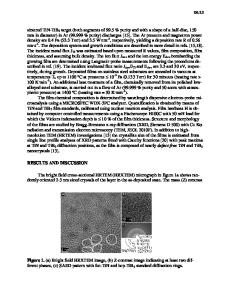Thermal stability of carbon nitride thin films
- PDF / 865,262 Bytes
- 14 Pages / 612 x 792 pts (letter) Page_size
- 55 Downloads / 344 Views
Virginie Serin and Stefano E. Grillo Centre d’Elaboration des Mate´riaux et Eludes Structurales/Centre de la Recherche Scientifique, B.P. 4347, 29 Rue Jeanne Marvig, F-31055 Toulouse, France
Ray Twesten and Ivan Petrov Center for Microanalysis of Materials, Frederick Seitz Materials Research Laboratory, University of Illinois, 104 South Goodwin Avenue, Urbana, Illinois 61801
Christian Colliex Laboratoire de Physique des Solides, Universite´ Paris-Sud, Baˆt. 510, F-91405 Orsay, France
Lars Hultman and Jan-Eric Sundgrenc) Thin Film Physics Division, Department of Physics, Linko¨ping University, S-581 83 Linko¨ping, Sweden (Received 26 February 2001; accepted 25 August 2001)
The thermal stability of carbon nitride films, deposited by reactive direct current magnetron sputtering in N2 discharge, was studied for postdeposition annealing temperatures TA up to 1000 °C. Films were grown at temperatures of 100 °C (amorphous structure) and 350 and 550 °C (fullerenelike structure) and were analyzed with respect to thickness, composition, microstructure, bonding structure, and mechanical properties as a function of TA and annealing time. All properties investigated were found to be stable for annealing up to 300 °C for long times (>48 h). For higher TA, nitrogen is lost from the films and graphitization takes place. At TA ⳱ 500 °C the graphitization process takes up to 48 h while at TA ⳱ 900 °C it takes less than 2 min. A comparison on the evolution of x-ray photoelectron spectroscopy, electron energy loss spectroscopy and Raman spectra during annealing shows that for TA > 800 °C, preferentially pyridinelike N and −C≡N is lost from the films, mainly in the form of molecular N2 and C2N2, while N substituted in graphite is preserved the longest in the structure. Films deposited at the higher temperature exhibit better thermal stability, but annealing at temperatures a few hundred degrees Celsius above the deposition temperature for long times is always detrimental for the mechanical properties of the films.
I. INTRODUCTION
Most attempts to synthesize carbon nitride compounds have resulted in amorphous films, and reports on pure crystalline films have been very rare. Furthermore, the nitrogen concentration is commonly found to be limited
a)
Address all correspondence to this author. Present address: Frederick Seitz Materials Research Laboratory, University of Illinois, 104 South Goodwin Avenue, Urbana, Illinois 61801. e-mail: [email protected] b) Present address: Max Planck Institute FKF, Heisenbergstraße 1, D-70569 Stuttgart, Germany. c) Present address: Office of the President, Chalmers University of Technology, S-412 96 Go¨teborg, Sweden. 3188
http://journals.cambridge.org
J. Mater. Res., Vol. 16, No. 11, Nov 2001 Downloaded: 20 Mar 2015
to rather low values, typically in the range 10–40 at.%. A lower deposition temperature normally gives the highest N incorporation, but a higher temperature would be required to form crystalline films. Synthesis of nitrogen-rich crystalline C–N films, such as C3N4, has thus proven to
Data Loading...










